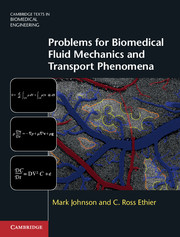3654 results in ebooks in fluid mechanics
4 - Dispersive waves and ray tracing
-
- Book:
- Waves and Mean Flows
- Published online:
- 05 April 2014
- Print publication:
- 06 March 2014, pp 56-98
-
- Chapter
- Export citation
References
-
- Book:
- Waves and Mean Flows
- Published online:
- 05 April 2014
- Print publication:
- 06 March 2014, pp 354-357
-
- Chapter
- Export citation
14 - Wave refraction by vortices
-
- Book:
- Waves and Mean Flows
- Published online:
- 05 April 2014
- Print publication:
- 06 March 2014, pp 335-353
-
- Chapter
- Export citation
6 - Internal gravity waves
-
- Book:
- Waves and Mean Flows
- Published online:
- 05 April 2014
- Print publication:
- 06 March 2014, pp 107-147
-
- Chapter
- Export citation
9 - Rossby waves and balanced dynamics
-
- Book:
- Waves and Mean Flows
- Published online:
- 05 April 2014
- Print publication:
- 06 March 2014, pp 194-213
-
- Chapter
- Export citation
7 - Shear flows
-
- Book:
- Waves and Mean Flows
- Published online:
- 05 April 2014
- Print publication:
- 06 March 2014, pp 148-177
-
- Chapter
- Export citation
10 - Lagrangian-mean theory
-
- Book:
- Waves and Mean Flows
- Published online:
- 05 April 2014
- Print publication:
- 06 March 2014, pp 214-258
-
- Chapter
- Export citation
11 - Zonally symmetric GLM theory
-
- Book:
- Waves and Mean Flows
- Published online:
- 05 April 2014
- Print publication:
- 06 March 2014, pp 259-274
-
- Chapter
- Export citation
3 - Geometric wave theory
-
- Book:
- Waves and Mean Flows
- Published online:
- 05 April 2014
- Print publication:
- 06 March 2014, pp 40-55
-
- Chapter
- Export citation
Index
-
- Book:
- Waves and Mean Flows
- Published online:
- 05 April 2014
- Print publication:
- 06 March 2014, pp 358-360
-
- Chapter
- Export citation
12 - A framework for local interactions
-
- Book:
- Waves and Mean Flows
- Published online:
- 05 April 2014
- Print publication:
- 06 March 2014, pp 277-305
-
- Chapter
- Export citation

Problems for Biomedical Fluid Mechanics and Transport Phenomena
-
- Published online:
- 18 December 2013
- Print publication:
- 09 December 2013
5 - Momentum boundary layers
-
- Book:
- Problems for Biomedical Fluid Mechanics and Transport Phenomena
- Published online:
- 18 December 2013
- Print publication:
- 09 December 2013, pp 60-65
-
- Chapter
- Export citation
8 - Non-Newtonian blood flow
-
- Book:
- Problems for Biomedical Fluid Mechanics and Transport Phenomena
- Published online:
- 18 December 2013
- Print publication:
- 09 December 2013, pp 74-79
-
- Chapter
- Export citation
Appendix A - Material properties of fluids
-
- Book:
- Problems for Biomedical Fluid Mechanics and Transport Phenomena
- Published online:
- 18 December 2013
- Print publication:
- 09 December 2013, pp 156-157
-
- Chapter
- Export citation
14 - Concentration and thermal boundarylayers
-
- Book:
- Problems for Biomedical Fluid Mechanics and Transport Phenomena
- Published online:
- 18 December 2013
- Print publication:
- 09 December 2013, pp 135-141
-
- Chapter
- Export citation
Dedication
-
- Book:
- Problems for Biomedical Fluid Mechanics and Transport Phenomena
- Published online:
- 18 December 2013
- Print publication:
- 09 December 2013, pp v-vi
-
- Chapter
- Export citation
Frontmatter
-
- Book:
- Problems for Biomedical Fluid Mechanics and Transport Phenomena
- Published online:
- 18 December 2013
- Print publication:
- 09 December 2013, pp i-iv
-
- Chapter
- Export citation
2 - Conservation of mass and theReynolds transport theorem
-
- Book:
- Problems for Biomedical Fluid Mechanics and Transport Phenomena
- Published online:
- 18 December 2013
- Print publication:
- 09 December 2013, pp 16-22
-
- Chapter
- Export citation
11 - Steady diffusion and conduction
-
- Book:
- Problems for Biomedical Fluid Mechanics and Transport Phenomena
- Published online:
- 18 December 2013
- Print publication:
- 09 December 2013, pp 90-102
-
- Chapter
- Export citation
